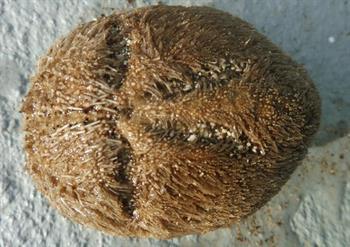



Meoma ventricosa
Size
To 15cm
Description:
Dome-shaped body with inverted pentagonal petal design on the back. Densly covered in short brown spines. Egg-shaped test, with flat underside, made of closely fitting, calcium carbonate plates. The mouth is on the oral (under) surface near the anterior end and the anus at the posterior end.
Ecology
Sand and seagrass beds. Usually buried.
It can emit a noxious yellow exudate which repels fish. Most adults have a parasitic relationship with one or more small crabs of the species Dissodactylus primitivus. The crab lives on the urchin, usually inside or near its mouth.
Feeds on biofilms by swallowing sediment while it burrows under the surface of the substrate. Fifty six tube feet situated near the mouth form a disc and mucus causes the sand particles to adhere to it. The disc is then retracted into the mouth and the particles swallowed. They are passed through the gut and the nutritive matter extracted in the process. The urchin's growth rate is slow as it is limited both by the amount of organic material that can be extracted in this way and also by the lack of oxygen in the sediment, especially at night. To overcome this limitation, adult urchins often emerge onto the seabed at night and burrow down into the sediment again next day while juveniles remain permanently buried.
Life Cycle
Spawning is not synchronized and fertilisation takes place in the water column. The larvae are planktonic and settle on the seabed in suitable sandy locations, perhaps guided there by chemical cues.
To 15cm
Description:
Dome-shaped body with inverted pentagonal petal design on the back. Densly covered in short brown spines. Egg-shaped test, with flat underside, made of closely fitting, calcium carbonate plates. The mouth is on the oral (under) surface near the anterior end and the anus at the posterior end.
Ecology
Sand and seagrass beds. Usually buried.
It can emit a noxious yellow exudate which repels fish. Most adults have a parasitic relationship with one or more small crabs of the species Dissodactylus primitivus. The crab lives on the urchin, usually inside or near its mouth.
Feeds on biofilms by swallowing sediment while it burrows under the surface of the substrate. Fifty six tube feet situated near the mouth form a disc and mucus causes the sand particles to adhere to it. The disc is then retracted into the mouth and the particles swallowed. They are passed through the gut and the nutritive matter extracted in the process. The urchin's growth rate is slow as it is limited both by the amount of organic material that can be extracted in this way and also by the lack of oxygen in the sediment, especially at night. To overcome this limitation, adult urchins often emerge onto the seabed at night and burrow down into the sediment again next day while juveniles remain permanently buried.
Life Cycle
Spawning is not synchronized and fertilisation takes place in the water column. The larvae are planktonic and settle on the seabed in suitable sandy locations, perhaps guided there by chemical cues.

| Ecological Descriptors | ||||
| Habitat | Size (cm) | Diet | Behaviour | Sex |
| S | 15 | Det | I | F |
Red Heart Urchin


447


